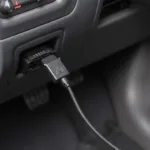OBD2 readings are the key to unlocking the secrets of your vehicle’s performance and health. Within the first 50 words of this guide, we’ll delve into the world of OBD2 readings, exploring what they are, how to interpret them, and why they’re essential for every car owner.
What are OBD2 Readings and Why Do They Matter?
OBD2, or On-Board Diagnostics II, is a standardized system that allows external devices, like OBD2 scanners, to communicate with your car’s computer. This system provides access to a wealth of data about your vehicle’s engine, transmission, emissions, and other crucial systems. These data points are presented as OBD2 readings, which can be anything from simple engine speed (RPM) to complex diagnostic trouble codes (DTCs). Understanding these readings empowers you to identify potential problems early on, potentially saving you time and money on costly repairs down the road.
For instance, a sudden drop in fuel economy could be indicated by an oxygen sensor reading outside the normal range. Alternatively, a consistently high coolant temperature might suggest a failing thermostat. These are just a few examples of how obd2 readings can provide valuable insights into your vehicle’s condition.
Decoding Common OBD2 Readings
There are hundreds of potential obd2 readings, but some are more common and essential than others. Let’s break down a few key readings you should be familiar with:
- Engine RPM: This shows how fast your engine is rotating, measured in revolutions per minute.
- Vehicle Speed: Indicates how fast your vehicle is traveling.
- Coolant Temperature: Measures the temperature of your engine coolant, crucial for preventing overheating.
- Fuel Level: Shows the amount of fuel remaining in your tank.
- Oxygen Sensor Readings (O2 Sensors): These sensors measure the amount of oxygen in your exhaust gases, helping to optimize fuel efficiency and reduce emissions.
- Mass Air Flow (MAF) Sensor Readings: Measures the amount of air entering the engine, important for proper fuel-air mixture.
- Diagnostic Trouble Codes (DTCs): These are alphanumeric codes that indicate specific malfunctions within your vehicle’s systems. These codes are essential for diagnosing problems accurately.
How to Use OBD2 Readings for Troubleshooting
OBD2 readings are more than just numbers; they are a powerful diagnostic tool. By understanding how to interpret these readings, you can effectively troubleshoot car problems and even perform preventative maintenance. Here’s how:
- Connect your OBD2 scanner: Locate your vehicle’s OBD2 port (usually under the dashboard on the driver’s side) and connect your scanner.
- Turn on the ignition: Turn the key to the “on” position without starting the engine.
- Read the codes: Use your scanner to read any stored DTCs. If there are any, write them down.
- Interpret the readings: Consult a reliable source, like an OBD2 code lookup database, to understand the meaning of the DTCs and other obd2 readings.
- Further investigation: Based on the information gathered, you can investigate the affected systems more thoroughly. For example, a DTC related to the oxygen sensor might require you to inspect the sensor itself for damage or fouling.
What Does a High OBD2 Reading Mean?
A high OBD2 reading, depending on the parameter, can indicate a variety of issues. For example, high coolant temperature can point to a failing thermostat, low coolant levels, or a malfunctioning cooling fan. High RPM at idle might suggest a vacuum leak or a faulty idle air control valve. Always refer to your vehicle’s specific repair manual or a trusted online resource for accurate interpretation of high obd2 readings.
OBD2 Readings: Empowering Car Owners
Understanding obd2 readings empowers you to take control of your vehicle’s maintenance and repair. While professional mechanics have advanced diagnostic equipment, basic OBD2 scanners and a little knowledge can go a long way in helping you identify and address potential problems before they escalate. By regularly monitoring your vehicle’s obd2 readings, you can stay ahead of the curve and keep your car running smoothly.
Looking for the best OBD2 apps to enhance your diagnostic capabilities? Check out our recommendations for the best obd2 apps for iphone and the best smartphone obd2 solutions.
In conclusion, obd2 readings provide a vital window into your car’s inner workings. By learning to interpret these readings, you can become a more informed car owner and potentially save money on repairs.
FAQ
- What does OBD2 stand for? On-Board Diagnostics II
- Where is the OBD2 port located? Usually under the dashboard on the driver’s side.
- Can I use an OBD2 scanner on any car? Most cars manufactured after 1996 in the US are OBD2 compliant.
- What are DTCs? Diagnostic Trouble Codes that indicate specific malfunctions.
- Do I need to be a mechanic to use an OBD2 scanner? No, basic scanners are user-friendly.
- What are the best phone app for obd2? Check out our dedicated article for recommendations.
- Where can I find more information on specific OBD2 codes? Online OBD2 code lookup databases are a great resource.
Need assistance? We’re here to help! Contact us via WhatsApp: +1(641)206-8880, Email: [email protected] or visit us at 789 Elm Street, San Francisco, CA 94102, USA. Our customer service team is available 24/7. You might also find our articles on the migliori app obd2 and best obd2 gauge app helpful.

